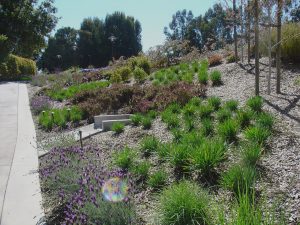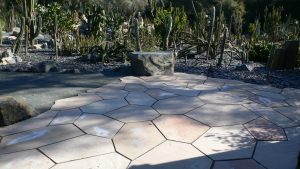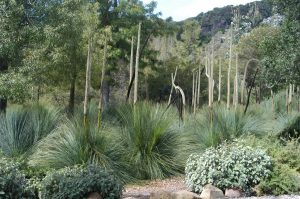
The concept of sustainable agriculture is not new and the idea of sustainable gardens is likely just as dated. Sustainability as a concept can be applied to soil, farms, gardens or life in the biosphere. The second law of thermodynamics says that all systems tend toward thermodynamic equilibrium where there is maximum entropy (randomness). In functional ecosystems equilibrium is achieved to a degree, and plant, animal and other species are at stable levels. Ecosystems evolved over millions of years to develop connections between individuals creating support networks, predator-prey cycles and nutrient cycles. Inputs are adequate to “sustain” the system and outputs are all recycled. When we create our gardens we are setting up a system that we maintain through inputs and we appreciate the outputs, and it keeps us interested and involved in pushing back the entropy. In almost all cases gardens are not natural systems and if left untended will become more random, weeds will grow, poorly adapted plants will be overrun and the balance will change to something matches the inputs and outputs of a sustainable system as dictated by the location/climate/soil, etc.

The key to a sustainable garden is understanding inputs and outputs and the flow of energy in your system. The reason I like pristine ecosystems is that I don’t have to add inputs to them to take part in their beauty. As long as I don’t interrupt what is going on by breaking connections between organisms unwittingly, the system is self sustaining. Imagine the garden of Eden that always bears fruit and flowers with no inputs from you the gardener. You just walk into the garden and bask in it sbeauty occasionally eating some delicious item you find there. Well we all know that our own circumstances are far from this reality. Getting a garden to provide the aesthetics (beauty) or food (both outputs) often requires us to provide heavy amounts of inputs. Inputs are mostly energy in the form of kinetic or work energy of the gardener, hydrocarbon energy in the form of electricity to run gadgets or fuel to power mowing or clipping equipment, or fertilizers which may be derived from fossil fuels or from the sun as by products of plants. Energy is also the main input into plant systems that may be in your garden. Light contains the energy for their growth. Finally cash money is easily converted to all forms of energy. You can purchase labor, fertilizer, any number of garden amenities bypassing the personal output of your own kinetic energy. Or you can garden smarter and avoid large energy inputs by creating the sustainable garden…
So how do we get a sustainable “Garden of Eden”. First, recognize that not all gardens are the same; they have different functions and purposes. Some are for aesthetics only. Some are for food production. There is a wide body of research that shows gardens and green environments sustain our health; both physical and mental (this would be an output). So a garden is not sustainable if it does not appeal to you or produce enough food or sustenance to justify the inputs. Gardens are like checking accounts in a way; we put in deposits (inputs) and we withdraw benefits (outputs). If the amount of inputs generate the required outputs the garden is sustainable. So since money converts to energy and labor the more money you have the more complicated and detailed your landscape or garden can be, but entropy will have its way with this kind of garden with out extensive inputs. Water thirsty plants, greenhouse cultivation, weed and other pest control, poorly adapted plants and wide swaths of turf all require greater inputs.

-Increase Hardscape
Hardscape includes landscape elements such as walkways, walls, boulders, patios, sculptures, small out buildings etc. Since hardscape is not green or growing it uses no water, requires no pruning or other tasks to maintain. Installing strategic hardscape can improve the appeal and functionality of a landscape while cutting down on the sustainable square footage that you are maintaining. It is often wise to consult a landscape designer or architect to optimize the uses and functions of your garden.
-Mulch Mulch Mulch
Fresh mulch from chipped tree trimmings is essential for a sustainable landscape/garden. Fresh wood chips are the best source of energy for microbes when used as a surface mulch. Wood chips layered four inches thick over bare soil will improve many aspects of soil, essentially making the soil more “sustainable” for your garden by conserving moisture and adding nutrients over time (for more on mulch see the paper by LCS referenced in the GP site). Fresh wood chips are best around perennials but can also be used as walkway material in vegetable gardens, as mulch around berries and fruit trees and around perennials like rhubarb and asparagus. A well mulched garden uses less water and, in time, requires little or no fertilization.

-Maintain Light
Sunlight is the main energy input into your garden and is necessary to sustain the plants growing there. Plants that are adapted to full sun when shaded out by growing trees, shrubs or other tall plants become disease prone, produce less fruit, and are less attractive. To keep vigor up, ensure that plants get enough sunlight by pruning back intruding branches from nearby trees or other shade providing plants. Remove trees that have outgrown their space in your garden and replant with size appropriate specimens.
-Use Enduring Plants
Grow what grows well for you. Time spend on poorly adapted and fussy plants will decrease the sustainability of your garden and increase the necessary inputs of time, labor and energy. For oranamental gardens use enduring plants. Flashy annual plants look good for a few months but require replacement regularly. Long lived perennials used as specimens in a garden add value over time with little care, pest control or fertilization. I term these ‘enduring plants’. Enduring plants grow slowly but live long lives. For those who grow food vegetable gardens are a necessity and plants are mostly annual, however perennials are also an option. Rhubarb is an enduring perennial, berry vines, fruit trees, asparagus and grapes provide food year after year with low maintenance relative to annual crops. Keep fussy, pet plants to a minimum, and in containers so they can be moved when necessary to accommodate their needs.

-Recycle Reuse
Gardeners spend a lot of energy clipping, removing and throwing away unwanted yardwastes. Consider composting trimmings and weeds and recycling these materials back into the garden. This reduces energy spent processing these materials and decreases the cost of purchasing organic materials for your garden. Lawn clipping, leaves, and tree trimmings (when shredded) can make a high quality compost if carefully produced. Many extension offices have publications on home compost production.
Study of natural ecosystems provides an interesting window into sustainable landscapes. Plants grow with each other in a balance or harmony that results in a sustainable landscape. In these natural settings, litter accumulates under tree canopies (think mulch in your garden) providing a continued source of biological and mineral motivation for soil to be productive. Annual plants grow each year where sun is abundant and shade loving perennials inhabit the understory of trees. The right plants in the right place create a beautiful environment.
The concept of entropy in natural systems is not helpful as it assumes that there is some equilibrium state to be reached.Natural systems are more fundamentally about succession and complexity. The picture for example of a virgin prairie being in a steady state misses a key dynamic which is that at any time either soil layers are building or they are declining. Equally in rain forests a so-called steady state does not exist. Nature is either building complexity (eg more species, more layers of soil, more total biological activity), or it is doing the opposite. Entropy as a concept relates to chemistry and physics, not to life. Therefore there is no such thing as a sustainable landscape, instead there is a direction of development – towards increasing complexity or away from it. It is why it is so important not to see the world as a collection of things (eg trees, grass, animals), but to see it as flows. The informing perspectives we have shape our ability to act.
Entropy DOES apply to life. It takes energy to keep living systems living, whether you are looking at the organism level or the ecosystem level. Energy enters most ecosystems through photosynthesis; without photosynthesis, the system (from organism to community) will disintegrate. “Sustainable” in the current vernacular simply means maintaining a landscape or garden with low to moderate environmental, economic, and social costs. Those are measurable and thus practical criteria.
One of my gardens is purposefully, a Darwin garden, in other words, survival of the fittest. A plant is thrown into the fray and it either survives or not. After 22 years, I am thinking of a change, but it was fun to see what stayed and what did not make it (as of right now, a tiger lily is the clear winner. Spiderwort has held its own, June berries are spreading. Also increasing that I did not plant, asparagus, black cap raspberry, lupine. Other species have held their own for 20 years. Various grasses and goldenrod the only serious weeds in this non-disturbed garden. Not bad).
Still, I was struck by the idea of ‘inputs’ and ‘outputs’ – and including beauty and pleasure as an output. If I continue to think about my gardens as a fight against encroaching entropy I’m certainly not doing much enjoying of it. When I feel I’ve done enough inputs I’m going to spend some time taking my allotted outputs by sipping lemonade on my screened-in porch!
Thanks for re-setting my garden brain, Dr. Downer.